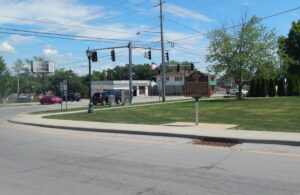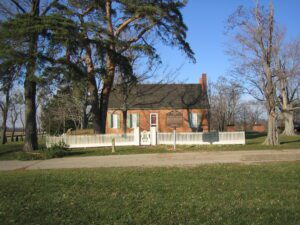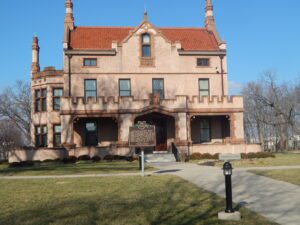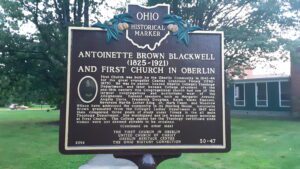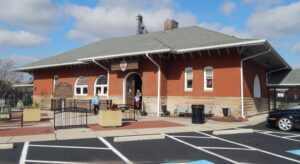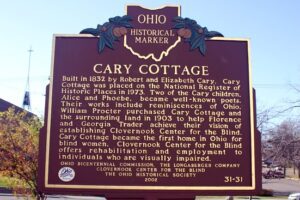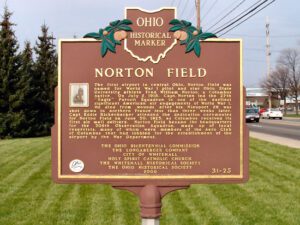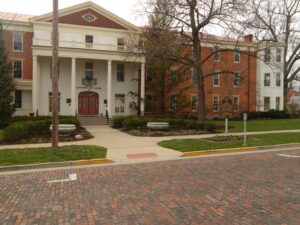, OH
Activity of the Underground Railroad is believed to have begun in Brookfield Township around 1838 with the first known runaway slaves, two women, to pass through in 1843. Freedom seekers moved north using a system of routes known by operators, or “conductors”. Trumbull County reputedly had over 150 miles of Underground Railroad routes, which would have made it the largest network in Ohio. The slaves that passed through Brookfield Township came mostly from the Youngstown, Poland, and the Canfield areas. From Brookfield they were sent north to Hartford, Kinsman, Burghill, and Vienna ultimately headed to Canada.
, OH
As Oxford Township was developing in the mid-1800s, a cluster of farmsteads near its northern border developed and was designated the “Doty Settlement.” As was the custom, the community took its name from a prominent family in the area. In or near the settlement were a church and cemetery, a school, a blacksmith shop, a sawmill, a distillery, a furniture shop, and a fulling mill for cleansing, shrinking, and thickening cloth. With the frontier spirit of self-reliance, it was seldom necessary to travel several miles into Oxford village for additional goods or services. Working together, the community farmed local fields and bartered for other items. Men, women, and children worked long, hard hours in the fields harvesting corn and wheat. It is evident that these families, living in an agricultural society, possessed many useful skills for surviving in the Ohio country.
, OH
Katharine Kennedy Brown (1891-1986), born in Dayton, was a leading figure in local, state, and national Republican politics. Soon after the 19th Amendment was passed in 1920, she earned a seat on the Montgomery County Republican Executive Committee; moving up to the Ohio State Republican Central Committee in 1928 and the Republican National Committee in 1932 ─ serving on both until 1968. She founded the first Republican Women’s Club in the county. (Continued other side)
, OH
First Church was built by the Oberlin Community in 1842-44 for the great evangelist Charles Grandison Finney (1792-1875). He was its pastor, headed Oberlin College’s Theology Department, and later became College president. In the mid-19th century this Congregational church had one of the largest congregations and auditoriums west of the Alleghenies. Eminent speakers such as Margaret Atwood, Angela Davis, Frederick Douglass, Ralph Waldo Emerson, Reverend Martin Luther King, Jr., Mark Twain, and Woodrow Wilson have addressed the community in its Meeting House. Antoinette Brown graduated from the College’s Ladies’ Department in 1847 and then completed three years of study under Finney in the all male Theology Department. She worshipped and led women’s prayer meetings at First Church. The College denied her the Theology certificate since women were not deemed suitable to be ordained. (continued on other side)
, OH
Construction of the Columbus, Piqua, and Indiana Central Railroad started in 1850 and was finished in 1854. Later referred to as the “Panhandle Railroad,” it ran from Columbus to Bradford. During the Civil War, the line carried supplies and troops and it was extended from Bradford to Richmond, Indiana. President Lincoln’s funeral train traveled the route on April 29, 1865. Eventually, three railway lines crossed Urbana: the Big Four, the Pennsylvania, and the Erie. “Corn brooms,” woolen cloth, horse carriages, and tinware were shipped by railroad to national markets and regular passenger service carried residents to destinations across the country, including Chicago, St. Louis, New York, and Washington, D.C. (Continued on other side)
, OH
Built in 1832 by Robert and Elizabeth Cary, Cary Cottage was placed on the National Register of Historic Places in 1973. Two of the Cary children, Alice and Phoebe, became well-known poets. Their works include reminiscences of Ohio. William Procter purchased Cary Cottage and the surrounding land in 1903 to help Florence and Georgia Trader achieve their vision of establishing Clovernook Center for the Blind. Cary Cottage became the first home in Ohio for blind women. Clovernook Center for the Blind offers rehabilitation and employment to individuals who are visually impaired.
, OH
The first airport in central Ohio, Norton Field was named for World War I pilot and star Ohio State University athlete Fred William Norton, a Columbus native. On July 2, 1918, Capt. Norton led the 27th “Eagle” Pursuit Squadron in one of the earliest significant American air engagements of World War I. He died from wounds after his Nieuport 28 was shot down in northern France less than three weeks later. Capt. Eddie Rickenbacker attended the dedication ceremonies for Norton Field on June 30, 1923, as Columbus received its first air mail delivery. Norton Field became the headquarters for the 308th Observation Squadron, made up of local reservists, many of whom were members of the Aero Club of Columbus that had lobbied for the establishment of the airport by the War Department.
, OH
Chartered in 1849, the Institute was the first of three women’s colleges established in Oxford. The original brick building was completed in 1850, and forms the core structure. The Reverend John Witherspoon Scott, a member of Miami University’s early faculty, headed the Institute. In 1867, the Institute merged with Oxford Female College and later became the Oxford College for Women. Miami University acquired the building in 1928; in 1930 the Daughters of the American Revolution rededicated it as the “Caroline Scott Harrison Memorial.” From 1929-1998 it served as a Miami dormitory, nicknamed “Ox College.” Since 2003, the three-story building has housed the Oxford Community Arts Center. The structure is the oldest extant women’s college building in Ohio. It was placed on the National Register of Historic Places in 1976.


